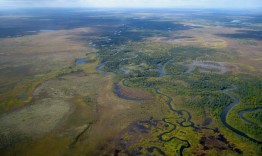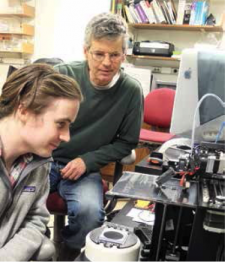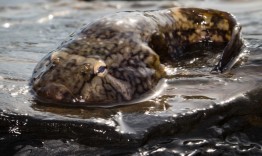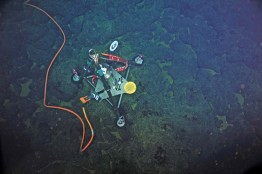Scientists from Aquatic and Fishery Sciences and other institutions are learning a lot about where Chinook salmon swim in Alaska’s Bristol Bay region through chemical signatures recorded in their ear bones. Similar to a tree’s growth rings, this bone—called an otolith—accumulates layers as the fish grows. Acting as a little recorder, each layer of the otolith corresponds to the unique chemical signatures of the waters in which they swam.
Read more at UW Today »New knowledge and technology help scientists track harmful algae
Though the waters of Puget Sound are full of beneficial algae, which provide oxygen, food, and shelter for other creatures, it’s the nasty ones that usually make the news, when they "bloom" into toxic pools, harming fish and humans. Now, researchers working with Washington Sea Grant have started to narrow in on harmful algae’s behaviors, and are developing some slick techniques that they hope will lead to much more effective detection and monitoring.
Read more »Fishermen, communities need more than healthy fish stocks
Aquatic and Fishery Sciences’ Chris Anderson and a team of scientists have developed a new assessment that looks at fisheries’ economic and community benefits, as well as ecological health. Anderson and his team created new ways of measuring three performance indicators – ecology, economics, and community – all of which can be applied across species, management approaches, and nations. To characterize a fishery, the authors drew on local experts’ knowledge, scoring each response and averaging them in each category.
Read more at UW Today »Puget Sound’s clingfish could inspire better medical devices, whale tags
Researchers at the University of Washington’s Friday Harbor Laboratories are studying the Northern clingfish, a finger-sized fish that scoots around the coastal waters of Puget Sound and can use suction forces to hold up to 150 times its own body weight. They’re trying to better understand how clingfish summon such massive power in wet, slimy environments—something current industrial suction devices can’t do—and if the biomechanics of clingfish could be instructive in designing surgical instruments and, possibly, a new way to tag whales without puncturing their skin with darts.
Read more at UW Today »Seafloor sensors record possible eruption of underwater volcano
Thanks to a set of high-tech instruments installed last summer by a team of scientists, many at the College of the Environment, the deep sea is online and scientists were able to observe the eruption of the Axial Volcano on April 23. About 300 miles offshore from Astoria, Oregon, and one mile deep, the data collected flowed back to the land at the speed of light through fiber optic cable.
Read more at UW Today »





